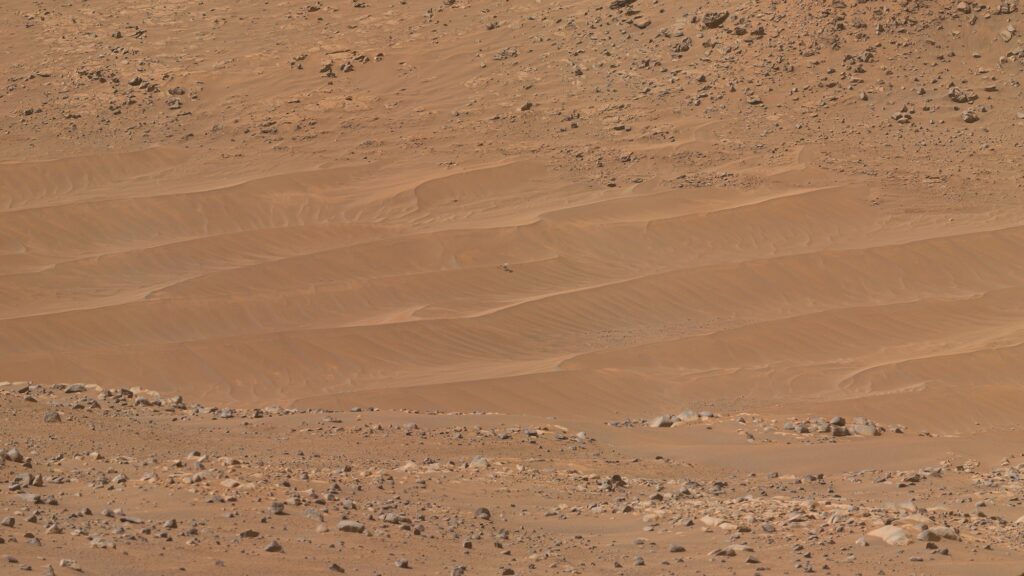On February 4, NASA’s Perseverance Rover snapped an image of its now defunct companion, the Ingenuity helicopter. The pair had spent almost three Earth years scouring the Red Planet for signs of ancient life, advancing aerial missions on Mars. The damaged ingenuity helicopter has been sitting there for just over two weeks.
[Related: RIP Mars Ingenuity, the ‘little helicopter that could.’]
The Perseverance Rover snapped the image at 1:05 p.m. global mean solar time that shows the “little helicopter that could” sitting alone on a barren Martian sand dune in Neretva Vallis. Perseverance rolled away from its broken companion, possibility for the last time. The image was beamed back to Earth and processed by visual design student Simeon Schmauss, who stitched together the six raw NASA images into a panorama.
— Simeon Schmauß (@stim3on) February 5, 2024
On January 18, Ingenuity’s rotors were damaged when it made a landing on what NASA called a “bland” patch of Martian landscape. Typically, the helicopter used rocks and other distinguishing features on the Red Planet to help it navigate, but the drone did not have many visual cues during its 72nd and final flight.
NASA confirmed that the rotocopter damaged at least one blade when it completed the flight. While it landed upright and was still in communication with NASA’s Jet Propulsion Laboratory (JPL), its flying days were officially over. The JPL is still analyzing the damage.
On January 31, NASA held a live streamed tribute to Ingenuity. “We couldn’t be prouder or happier with how our little baby has done,” Ingenuity Project Manager Teddy Tzanetos said during the event. “It’s been the mission of a lifetime for all of us. And I wanted to say thank you to all of the people here that gave their weekends, their late nights. All the engineers, the aerodynamic scientists, the technicians who hand-crafted this aircraft.”
Ingenuity first landed on Mars on February 18, 2021. By April, it became the first powered aircraft to lift off from the surface of another planet. Ingenuity was initially intended to do five test flights with the Perseverance over 30 days. However, this four pound helicopter just kept going. It flew 14 times farther than planned and had a total flight time of two hours. Ingenuity hovered above the rover acting as a scout, as Perseverance puttered along the sands of Mars. It lasted about 33 times longer than NASA expected.
[Related: Name a better duo than NASA’s hard-working Mars rover and helicopter.]
Before Ingenuity’s demise, the dynamic duo explored Mars’ Jezero Crater. This site contains evidence of ancient bodies of water that could have harbored life billions of years ago. Ingenuity worked by capturing aerial views of Mars that pinpointed places for Perseverance to explore further.
During the January 31 livestream, NASA’s Mars Exploration Program Deputy Director Tiffany Morgan said that Ingenuity will have a lasting legacy for future aerial missions, and demonstrated how to use helicopters in missions to other planets
Thanks in part to Ingenuity’s success, NASA has proposed using two helicopters in a planned Mars Sample Return mission. These small aircraft could help pick up the canisters of rock samples that the rover has been placing along the planet’s surface. The orbiter for this mission is expected to launch in 2027 and the lander in 2028, with the samples returned to Earth as early as 2033.
Until then, Perseverance must go it alone.
>>> Read full article>>>
Copyright for syndicated content belongs to the linked Source : Popular Science – https://www.popsci.com/science/perseverance-ingenuity/
